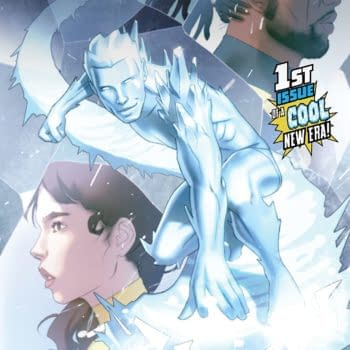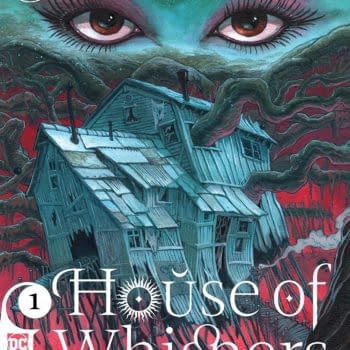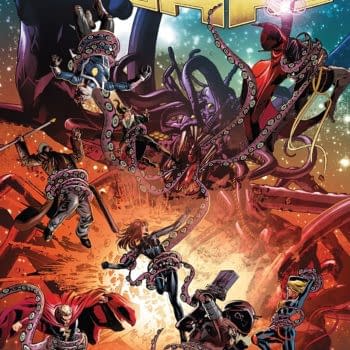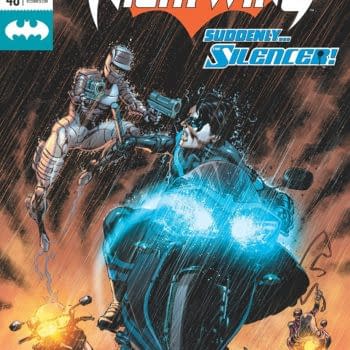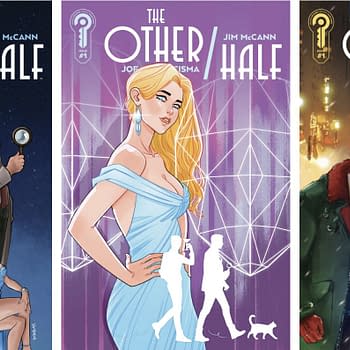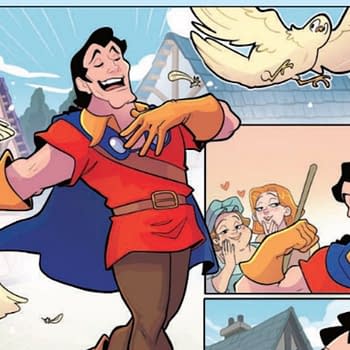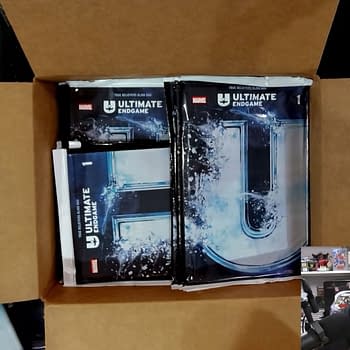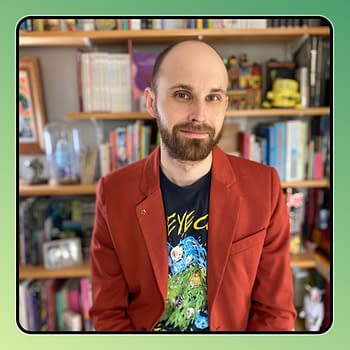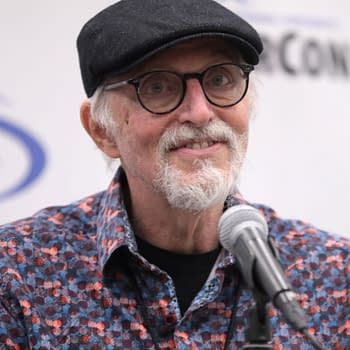Posted in: Comics, DC Comics, Review | Tagged: aco, black canary, casey brinke, crazy jane, danny the street, dc comics, doom patrol, flex mentallo, gerard way, justice league of america, Killer Frost, lobo, Magdalene Visaggio, marrissa louise, negative man, robot man, Sonny Liew, steve orlando, superman, Tamra Bonvillain, The Atom, the ray, vixen., young animals
JLA/Doom Patrol Special #1 Review: Strange, Meta, Yet Still Clichéd
Retconn is trying to sell off Prime Earth to a buyer, and the ground zero for making Prime Earth more appealing is Happy Harbor, Rhode Island. They have made it into a homogenized Rockwellian nightmare, with Milkman Man keeping the populace dosed with a milk to keep them this way.
The Doom Patrol arrives into this phenomenon, their oddities and quirks making them an immediate target for Milkman Man and the Rhode Island Community League, the latter of which was the Justice League of America not too long ago. Can the Doom Patrol save the Justice League?
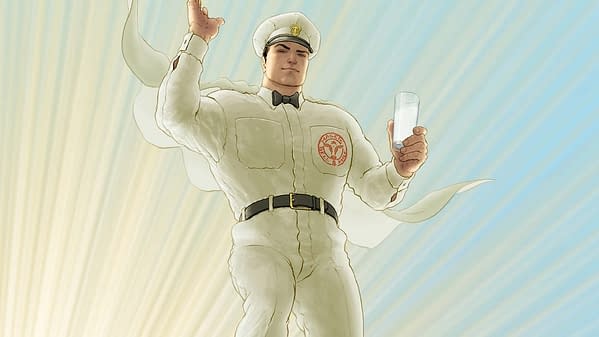
As a disclaimer, I read the first issue to Gerard Way's Doom Patrol when it came out a year and a half ago. I wasn't a fan at all, though I will fully admit I was hoping for a more conventional superhero book in the vein of John Byrne's run on the book. It goes without saying that Way's was far removed from both that and even the Vertigo fare, but there were things beyond it missing my expectations that turned me off to the book. Among these flaws was the book's fascination with how damn quirky it is.
Regardless, I was curious as to how the long-awaited crossover with the Justice League of America would turn out. The Doom Patrol team is more formed now, and maybe its connection with a title I generally quite like would coalesce into an enjoyable story with the likes of Robot Man and Negative Man.
The Doom Patrol's thematic fascination with how weird it is has definitely not receded. In fact, it is necessary to saving the day, as you could likely guess from the presence of a Rockwellian nightmare a-la Pleasentville, Marvel's Standoff: Assault on Pleasant Hill story, or, more recently, Suburbicon. Unlike those, it's using the aesthetic as a shorthand for homogeny and marketability.
We'll loop back around to the 1950s theme as shorthand and what the JLA/Doom Patrol Special #1, as well as many other stories with this theme miss. In the interim, we'll focus on the plot and the characters.
A positive quality of the comic is some of the bonding and camaraderie that happens between the JLA and the Doom Patrol. Robot Man, Negative Man, and Lobo pal around a little, Jane comforts Killer Frost about her personal issues.
The self-referential "we're in a comic book" angle of the Patrol as well as other comics like Deadpool, Multiversity, or that last issue of Suicide Squad, is becoming very stale. Something interesting needs to be done with a premise like that. Otherwise, the self-reference can seem very pompous. This crossover doesn't do anything interesting with the premise beyond paying some admitted lip service to the importance of origins and the culturally disruptive potential of comic books. If it expanded on those latter themes, the comic would be a lot better for it.
Retconn's attempts to homogenize Earth Prime is a fairly tired attempt to be metatextual. The Doom Patrol disrupting that with their "crazy colored hair" and quirkiness feels like the story further self-aggrandizing on how unique their superhero team is.
I'm always going to champion a varied output, even when the variety isn't all for me. That's the nature of reality, and it should be celebrated. However, there is a hint of arrogance in Doom Patrol's congratulating itself as the hero for "keeping DC weird." Contrasting itself against the JLA is especially odd, because, despite the stories from Steve Orlando's Justice League of America do tend to be fairly conventional, the team itself is quite diverse and odd compared to the mainline JL team, the Titans, and even the Teen Titans.
That loops back to the 1950s homogeny-as-shorthand angle, and this is something that this comic as well as things like Pleasantville and Standoff: Assault on Pleasant Hill overlook. Two of the primary factors which led to that homogeny of 1950s America which this aesthetic is taken from are overwhelming racism and sexism.
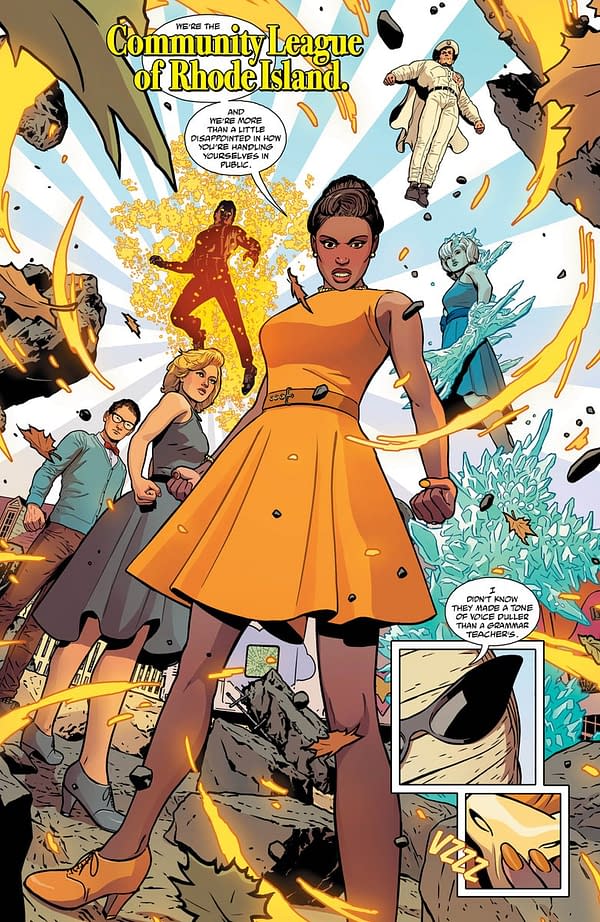
The 1950s culture this comic is referencing as a tool for its story is the Leave it to Beaver/Father Knows Best culture of that decade which is widely remembered as the dominant ideal of the era: white family, housewife, dad is the breadwinner. There is always more to a decade than its best-remembered iconography, but that iconography is what this comic is drawing upon. As such, that's what we're discussing here.
The JLA/Doom Patrol special has this aesthetic representing a nightmare scenario wherein the JLA are used to victimizing the Doom Patrol for being different. The inherent message by the end is that it's good to have variety. On the surface, I completely agree with that. However, it's missing a couple of points, the main one being the largest informant for homogeny in any era, but especially in the 1950s aesthetic they're drawing upon: a lack of diversity.
POC and women are largely silenced in that 1950s culture. Claiming that it's just the "weirdoes" and "geeks" that were victimized is horrendously reductive, and many of the other media like Pleasantville and Suburgatory seem intent on pushing that narrative.
The comics industry and American culture at large are doing better about getting different types of voices head in art and media, but it's far from perfect. Look at the books like Luke Cage, Iceman, Generation X, and America being axed by Marvel or DC's main stable of titles still being largely dominated by straight white guys.
The grand irony is that the all-white Doom Patrol refers to the JLA being ordinary, but they are a fairly ethnically diverse team in the grand scheme of DC's comic lineup right now.
Also "Milkman Man" is a horrid name, even as a joke.
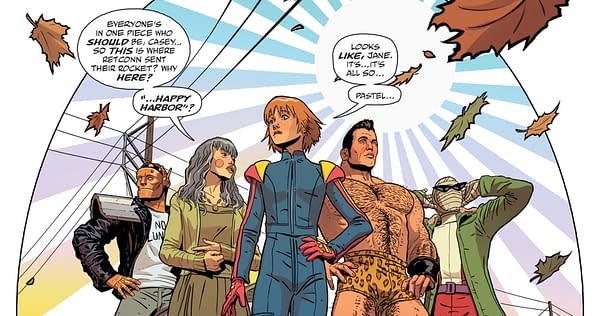
There's a back-up snippet about a George Sumner character called "The Formless Girl." There's not much to say about it. It's kind of cool, but it's there and gone in two pages. Sonny Liew's art and coloring looks really good, though.
To finally move onto the art, it's mostly quite good. Aco has a solid aesthetic that jives with the 1950s throwback world. Robot Man and Negative Man look really cool. The JLA are done some visual justice. The paneling feels oddly restrictive at times. That may have been intentional, but it does suffocate the art at times. The big fight between the JLA and the Doom Patrol is displayed in a pair of two-page spreads that are intended to be out-there and psychedelic but really more visually confusing than anything. Hugo Petrus gets a page resembling an old black-and-white television show that looks pretty cool.
Tamra Bonvillain and Marissa Louise's color art is quite good. They use the aforementioned pastel colors quite liberally, but the shades of the heroes' costumes contrast it very well.
This review turned out a bit longer than expected.
In any case, the JLA/Doom Patrol Special #1 is alright at best and frustrating at worse. Again, I'll admit that Way's Doom Patrol is really not my thing, but even beyond personal taste, this comic feels pretty self-congratulatory despite using a very well-worn premise of "weirdoes" in the Leave it to Beaver/Father Knows Best nightmare. It's not awful. There are some fun moments and good character interactions. However, the whole venture wavers towards mediocrity more than anything else. If you're a big fan of Way's Doom Patrol, you may still be entertained and engaged. Otherwise, I don't recommend it, and it's certainly not a must-buy.
Edit: I meant Keith Giffen, not John Byrne. Giffen's material is the one I more preferred.
Also, calling Way's Doom Patrol a far cry from the Vertigo material is an overstatement. They are similar in a lot of ways, though I will hold that the Young Animals DP is more pleased with itself in terms of tone.


